2018 KIA K900 checking oil
[x] Cancel search: checking oilPage 238 of 544
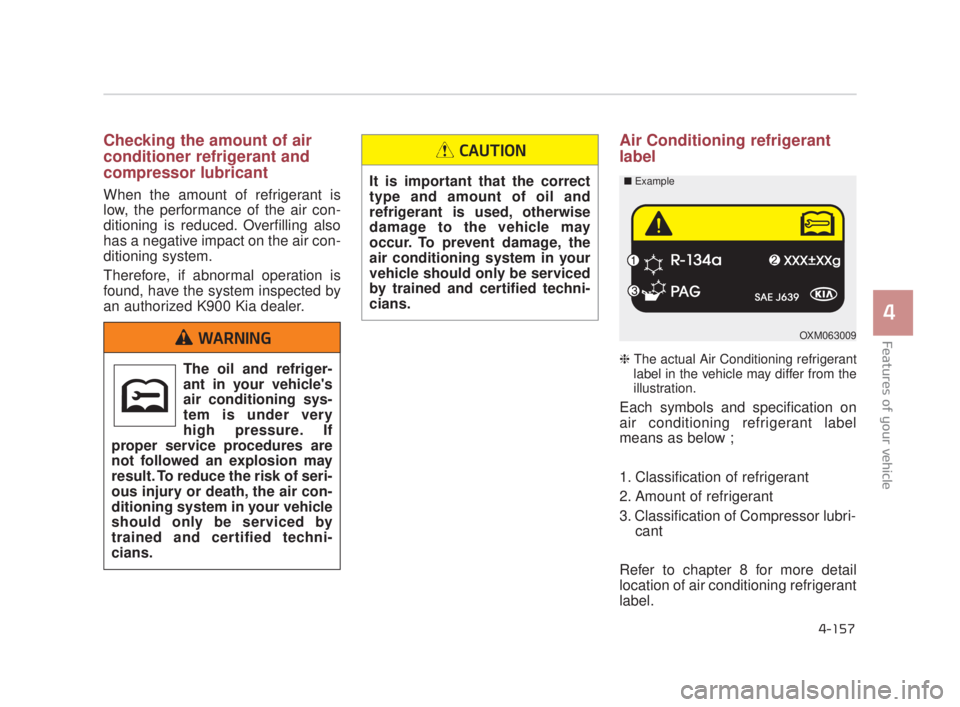
Features of your vehicle
4
4-157
Checking the amount of air
conditioner refrigerant and
compressor lubricant
When the amount of refrigerant is
low, the performance of the air con-
ditioning is reduced. Overfilling also
has a negative impact on the air con-
ditioning system.
Therefore, if abnormal operation is
found, have the system inspected by
an authorized K900 Kia dealer.
Air Conditioning refrigerant
label
❈The actual Air Conditioning refrigerant
label in the vehicle may differ from the
illustration.
Each symbols and specification on
air conditioning refrigerant label
means as below ;
1. Classification of refrigerant
2. Amount of refrigerant
3. Classification of Compressor lubri- cant
Refer to chapter 8 for more detail
location of air conditioning refrigerant
label.
OXM063009
■
Example
The oil and refriger-
ant in your vehicle's
air conditioning sys-
tem is under very
high pressure. If
proper service procedures are
not followed an explosion may
result. To reduce the risk of seri-
ous injury or death, the air con-
ditioning system in your vehicle
should only be serviced by
trained and certified techni-
cians.
WARNING
It is important that the correct
type and amount of oil and
refrigerant is used, otherwise
damage to the vehicle may
occur. To prevent damage, the
air conditioning system in your
vehicle should only be serviced
by trained and certified techni-
cians.
CAUTION
KH USA 4:2018 4/18/2017 6:03 PM Page 157
Page 409 of 544
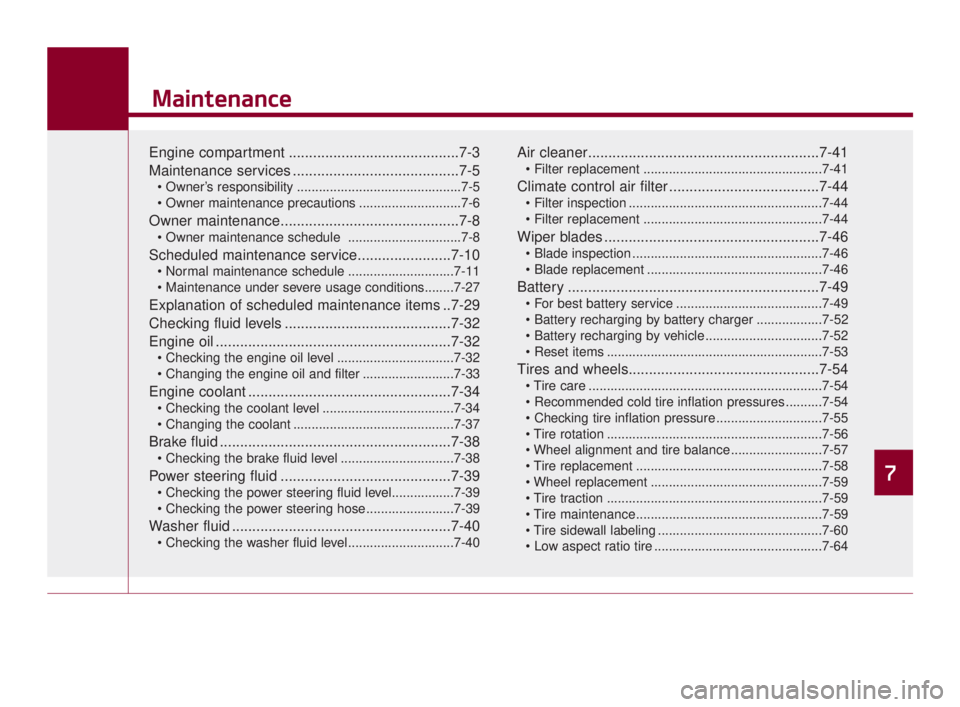
7
Maintenance
Engine compartment ..........................................7-3
Maintenance services .........................................7-5
.............................................7-5
............................7-6
Owner maintenance............................................7-8
...............................7-8
Scheduled maintenance service.......................7-10
.............................7-11
Explanation of scheduled maintenance items ..7-29
Checking fluid levels .........................................7-32
Engine oil ..........................................................7-32
................................7-32
.........................7-33
Engine coolant ..................................................7-34
....................................7-34
............................................7-37
Brake fluid .........................................................7-38
...............................7-38
Power steering fluid ..........................................7-39
Washer fluid ......................................................7-40
.............................7-40
Air cleaner.........................................................7-41
.................................................7-41
Climate control air filter .....................................7-44
.....................................................7-44
.................................................7-44
Wiper blades .....................................................7-46
....................................................7-46
................................................7-46
Battery ..............................................................7-49
........................................7-49
..................7-52
................................7-52
...........................................................7-53
Tires and wheels...............................................7-54
................................................................7-54
..........7-54
.............................7-55
...........................................................7-56
.........................7-57
...................................................7-58
...............................................7-59
...........................................................7-59
.............................................7-60
..............................................7-64
7
KH USA 7:2018 4/14/2017 6:36 PM Page 1
Page 415 of 544
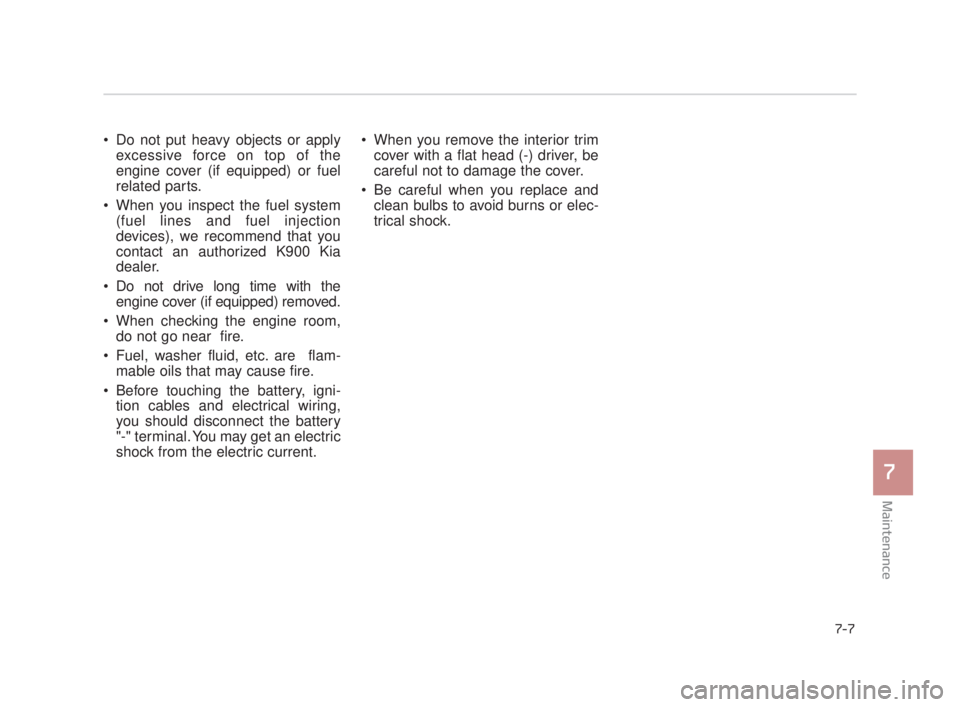
Do not put heavy objects or applyexcessive force on top of the
engine cover (if equipped) or fuel
related parts.
When you inspect the fuel system (fuel lines and fuel injection
devices), we recommend that you
contact an authorized K900 Kia
dealer.
Do not drive long time with the engine cover (if equipped) removed.
When checking the engine room, do not go near fire.
Fuel, washer fluid, etc. are flam- mable oils that may cause fire.
Before touching the battery, igni- tion cables and electrical wiring,
you should disconnect the battery
"-" terminal. You may get an electric
shock from the electric current. When you remove the interior trim
cover with a flat head (-) driver, be
careful not to damage the cover.
Be careful when you replace and clean bulbs to avoid burns or elec-
trical shock.
Maintenance
7
7-7
KH USA 7:2018 4/14/2017 6:37 PM Page 7
Page 416 of 544
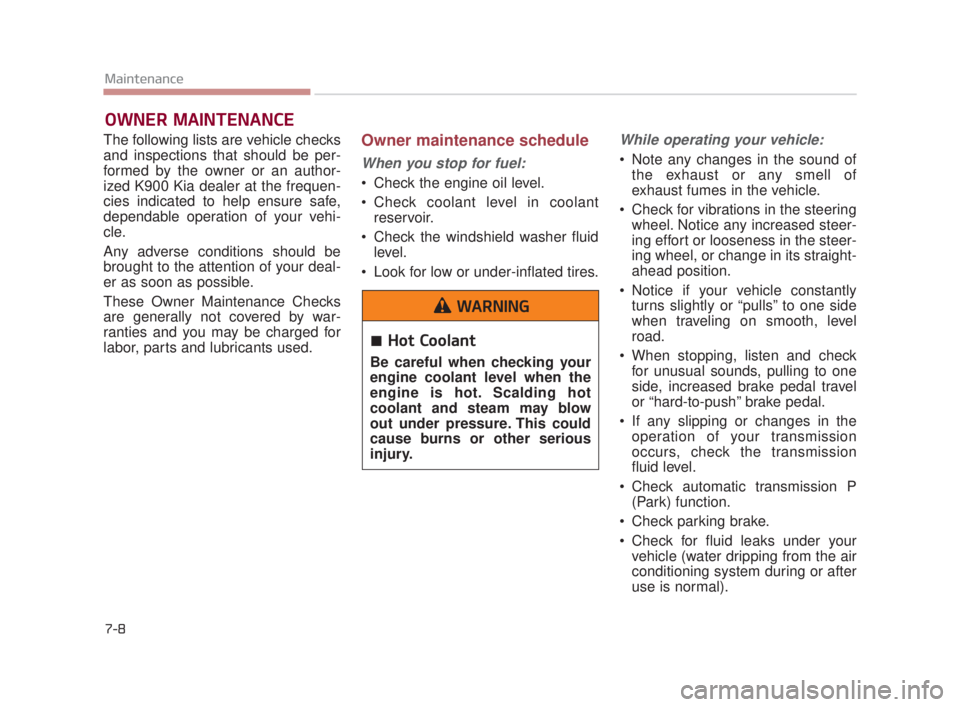
7-8
Maintenance
OWNER MAINTENANCE
The following lists are vehicle checks
and inspections that should be per-
formed by the owner or an author-
ized K900 Kia dealer at the frequen-
cies indicated to help ensure safe,
dependable operation of your vehi-
cle.
Any adverse conditions should be
brought to the attention of your deal-
er as soon as possible.
These Owner Maintenance Checks
are generally not covered by war-
ranties and you may be charged for
labor, parts and lubricants used. Owner maintenance schedule
When you stop for fuel:
Check the engine oil level.
Check coolant level in coolantreservoir.
Check the windshield washer fluid level.
Look for low or under-inflated tires.
While operating your vehicle:
Note any changes in the sound of the exhaust or any smell of
exhaust fumes in the vehicle.
Check for vibrations in the steering wheel. Notice any increased steer-
ing effort or looseness in the steer-
ing wheel, or change in its straight-
ahead position.
Notice if your vehicle constantly turns slightly or “pulls” to one side
when traveling on smooth, level
road.
When stopping, listen and check for unusual sounds, pulling to one
side, increased brake pedal travel
or “hard-to-push” brake pedal.
If any slipping or changes in the operation of your transmission
occurs, check the transmission
fluid level.
Check automatic transmission P (Park) function.
Check parking brake.
Check for fluid leaks under your vehicle (water dripping from the air
conditioning system during or after
use is normal).
Hot Coolant
Be careful when checking your
engine coolant level when the
engine is hot. Scalding hot
coolant and steam may blow
out under pressure. This could
cause burns or other serious
injury.
WARNING
KH USA 7:2018 4/14/2017 6:37 PM Page 8
Page 440 of 544
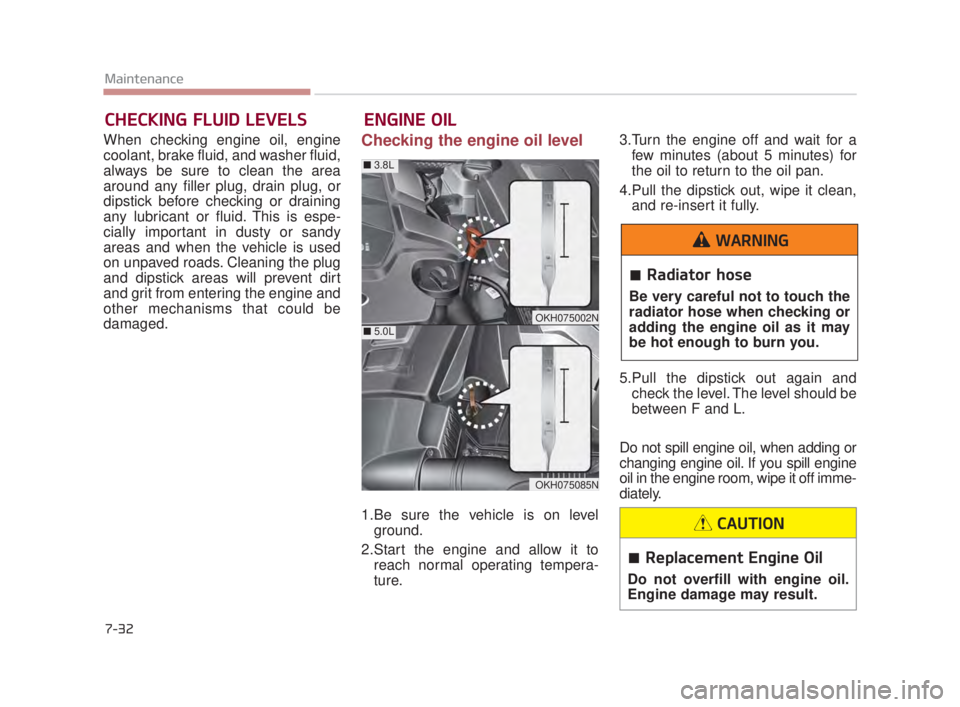
7-32
Maintenance
ENGINE OIL
CHECKING FLUID LEVELS
When checking engine oil, engine
coolant, brake fluid, and washer fluid,
always be sure to clean the area
around any filler plug, drain plug, or
dipstick before checking or draining
any lubricant or fluid. This is espe-
cially important in dusty or sandy
areas and when the vehicle is used
on unpaved roads. Cleaning the plug
and dipstick areas will prevent dirt
and grit from entering the engine and
other mechanisms that could be
damaged.Checking the engine oil level
1.Be sure the vehicle is on level
ground.
2.Start the engine and allow it to reach normal operating tempera-
ture. 3.Turn the engine off and wait for a
few minutes (about 5 minutes) for
the oil to return to the oil pan.
4.Pull the dipstick out, wipe it clean, and re-insert it fully.
5.Pull the dipstick out again and check the level. The level should be
between F and L.
Do not spill engine oil, when adding or
changing engine oil. If you spill engine
oil in the engine room, wipe it off imme-
diately.
Replacement Engine Oil
Do not overfill with engine oil.
Engine damage may result.
CAUTION
Radiator hose
Be very careful not to touch the
radiator hose when checking or
adding the engine oil as it may
be hot enough to burn you.
WARNING
OKH075002N
OKH075085N
■ 3.8L
■ 5.0L
KH USA 7:2018 4/14/2017 6:37 PM Page 32
Page 446 of 544
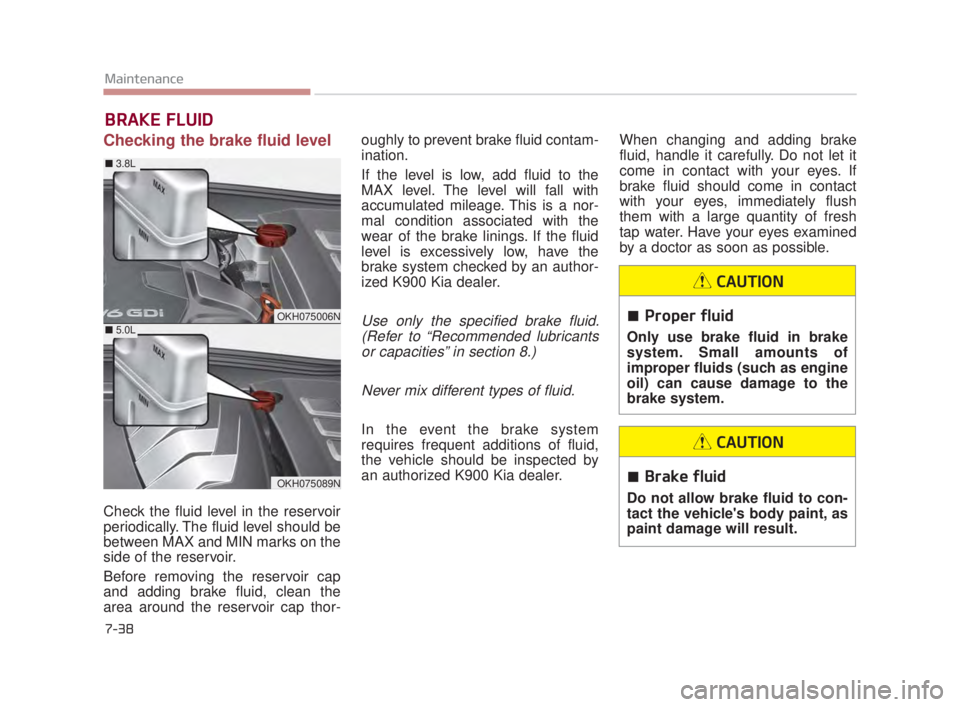
7-38
Maintenance
BRAKE FLUID
Checking the brake fluid level
Check the fluid level in the reservoir
periodically. The fluid level should be
between MAX and MIN marks on the
side of the reservoir.
Before removing the reservoir cap
and adding brake fluid, clean the
area around the reservoir cap thor-oughly to prevent brake fluid contam-
ination.
If the level is low, add fluid to the
MAX level. The level will fall with
accumulated mileage. This is a nor-
mal condition associated with the
wear of the brake linings. If the fluid
level is excessively low, have the
brake system checked by an author-
ized K900 Kia dealer.
Use only the specified brake fluid.
(Refer to “Recommended lubricantsor capacities” in section 8.)
Never mix different types of fluid.
In the event the brake system
requires frequent additions of fluid,
the vehicle should be inspected by
an authorized K900 Kia dealer. When changing and adding brake
fluid, handle it carefully. Do not let it
come in contact with your eyes. If
brake fluid should come in contact
with your eyes, immediately flush
them with a large quantity of fresh
tap water. Have your eyes examined
by a doctor as soon as possible.
Proper fluid
Only use brake fluid in brake
system. Small amounts of
improper fluids (such as engine
oil) can cause damage to the
brake system.
CAUTION
Brake fluid
Do not allow brake fluid to con-
tact the vehicle's body paint, as
paint damage will result.
CAUTION
OKH075006N
OKH075089N
■
3.8L
■ 5.0L
KH USA 7:2018 4/14/2017 6:37 PM Page 38
Page 447 of 544
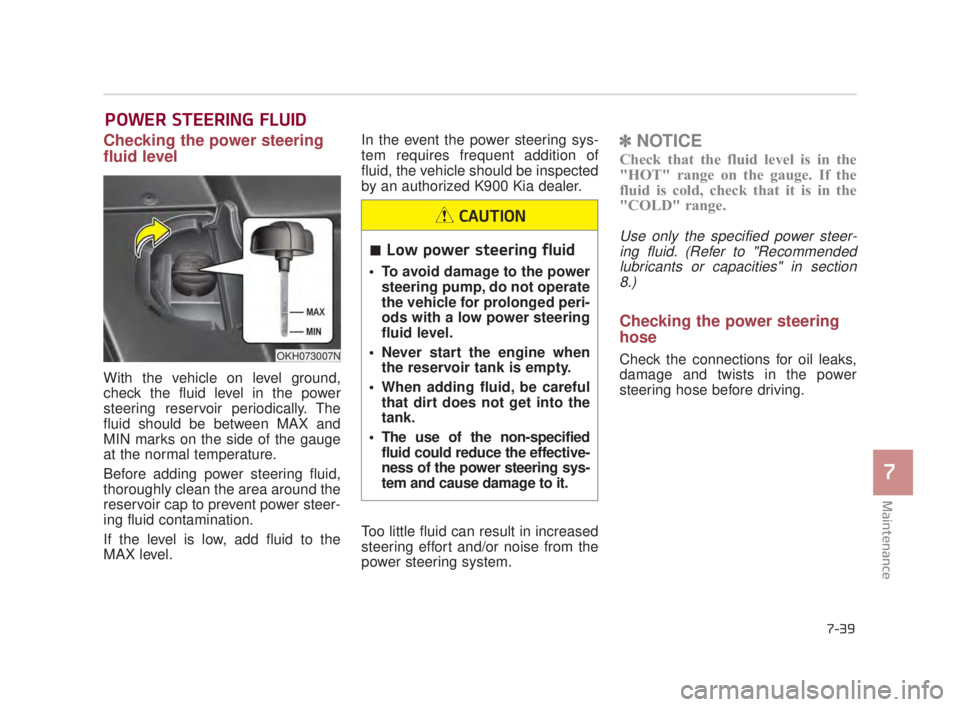
Maintenance
7
7-39
POWER STEERING FLUID
Checking the power steering
fluid level
With the vehicle on level ground,
check the fluid level in the power
steering reservoir periodically. The
fluid should be between MAX and
MIN marks on the side of the gauge
at the normal temperature.
Before adding power steering fluid,
thoroughly clean the area around the
reservoir cap to prevent power steer-
ing fluid contamination.
If the level is low, add fluid to the
MAX level.In the event the power steering sys-
tem requires frequent addition of
fluid, the vehicle should be inspected
by an authorized K900 Kia dealer.
Too little fluid can result in increased
steering effort and/or noise from the
power steering system.
✽
NOTICE
Check that the fluid level is in the
"HOT" range on the gauge. If the
fluid is cold, check that it is in the
"COLD" range.
Use only the specified power steer-
ing fluid. (Refer to "Recommendedlubricants or capacities" in section8.)
Checking the power steering
hose
Check the connections for oil leaks,
damage and twists in the power
steering hose before driving.
Low power steering fluid
To avoid damage to the power steering pump, do not operate
the vehicle for prolonged peri-
ods with a low power steering
fluid level.
Never start the engine when the reservoir tank is empty.
When adding fluid, be careful that dirt does not get into the
tank.
The use of the non-specified fluid could reduce the effective-
ness of the power steering sys-
tem and cause damage to it.
CAUTION
OKH073007N
KH USA 7:2018 4/14/2017 6:37 PM Page 39